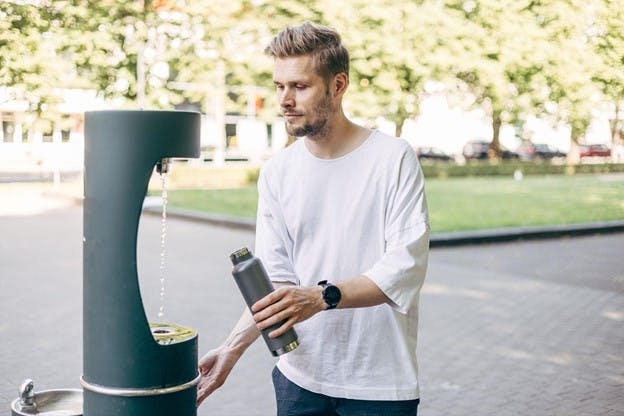March 2024
Everyday Solutions to Eliminate Plastic Bottle Waste
Plastic is by far the most used synthetic packaging material across the globe. From water bottles to food containers, tons of plastic products find their way into our homes every day. Plastic may seem like the holy grail material we need to streamline our day-to-day lives. However, plastic causes more harm than good. Plastic pollution is a pressing global problem inflicting a detrimental impact on the environment. According to the United Nations Environment Programme, 2,000 garbage trucks' worth of plastic are dumped into the world’s oceans, lakes, and rivers every day. While many initiatives have been launched to try to reduce plastic pollution, the global output of plastic waste is still alarming.
Plastic is the most favored material for making a lot of packaging materials because it’s convenient, portable, and cheap to produce. Plastic bottles contribute the most to global plastic waste since they are often used once and discarded. Every minute, consumers across the globe buy over a million plastic water bottles, with more than 80% of them ending up as waste. The degradation process for plastic bottle waste can extend up to 1000 years. To tackle the plastic pollution problem, we need to reduce and aim to eliminate plastic bottle waste.
In this article, we’ll explore the plastic pollution problem in detail and review some sustainable strategies to eliminate plastic bottle waste. Let’s dive in.
Why Do We Need to Eliminate Plastic Bottle Waste?
Plastic bottles make up a huge portion of global plastic waste. Plastic bottles are used to package beverages and many fast-moving household items. To understand their impact and the need to eliminate them, let’s look at why plastic waste is such a huge concern.
Plastic waste poses a threat to the environment, threatening the balance and existence of several crucial ecosystems. The negative environmental impacts of plastic result from its non-biodegradable nature.
Non-biodegradable items are materials that don’t easily decompose into natural elements. Non-biodegradable materials remain intact for years, altering the integrity and safety of the environment. In the case of plastic, they are made up of long chemical structures called polymers.
Polymers are durable and resistant to degradation. Plastics can remain in the environment for hundreds of years, a feature which makes them harmful. While they may be broken down into smaller fragments, they are not truly biodegradable compared to biological materials. Some estimates show that plastics take at least 400 years to fully break down.
Plastic waste poses several risks to natural ecosystems. Most plastic wastes end up in rivers, lakes, and oceans. Plastics threaten the balance of aquatic ecosystems. Millions of aquatic animals are killed by plastics every year. Once in the seas and oceans, plastics are broken down into tiny fragments called microplastics. These fragments measure less than one-fifth of an inch.
Microplastics can be mistaken for food or swallowed accidentally by fish and other aquatic animals. Either way, they may block or pierce their digestive organs, causing death in many cases. Apart from physical harm, microplastics may cause starvation by lowering the sensation of hunger since they are not easily expelled from the digestive system. Microplastics have been found in many species destined for human consumption including fish, mussels, and shrimps. Land animals are also affected when they consume plastic waste.
Aside from their impact on natural ecosystems, plastic waste can affect air quality and human health. More than 2 billion people in the world lack functional waste collection services, and incineration is their only way to get rid of their waste. Burning plastic waste exposes people to toxic contaminants in the smoke. The burning plastics release pollutants like dioxins, bisphenols, and phthalates.
These pollutants can cause breathing difficulties, nasal irritation, coughing, and headaches. People with underlying conditions such as respiratory diseases, heart diseases, and allergies are especially sensitive to air pollution caused by burning plastics. Long-term health problems can result from the release of nitrogen oxides, sulfur oxides, volatile organic chemicals, and polycyclic organic matter.
On a broader scale, plastic pollution has been shown to contribute to climate change. Plastics are responsible for about 4% of greenhouse gas (GHG) emissions. GHG emissions are a product of either the production or conversion stage of the plastic lifecycle.
During production, most plastics use fossil fuels. Biobased plastics would be a better option, but they require additional land, which may further cause deforestation. The conversation stage of plastics involves incineration, which releases toxic GHGs into the atmosphere. In the end, both processes accelerate the climate change crisis.

How Can We Reduce or Eliminate Plastic Bottle Waste?
Plastic bottle waste is a huge menace to both the environment and public health standards. Here are some active steps you can take to reduce plastic bottle waste.
1. Use Reusable Water Bottles
One of the best ways to reduce plastic bottle waste is to invest in reusable water bottles. Single-use water bottles are notorious for generating unnecessary plastic waste, and their impact on the environment can't be ignored. Reusable water bottles, on the other hand, are better for the environment and more cost-effective in the long run.
Reusable water bottles come in many shapes, styles, and materials. Choose a brand that is safe, durable, and portable. Reusable bottles made from glass or food-grade stainless steel are better than reusable plastic because they are non-toxic and easy to clean.
2. Invest in a Water Filter
Many people purchase bottled water because of its purity and flavor. However, home water filters are now widely available and affordable enough for many households. With regular tap water, you can achieve the same quality as bottled water.
Water filters purify drinking water and remove impurities, getting rid of any unpleasant taste in water. There are many benefits of using water filters. Investing in a water filter will not only help you minimize plastic waste but also improve your family’s health. In addition, drinking bottled water is expensive in the long run, and water filters present a more affordable solution.
3. Opt for Eco-Friendly Alternatives to Household Items
Apart from water and drinks, plastic bottles are used to package other household items. For example, bathroom essentials such as soaps, detergents, and shampoos are often packaged in plastic containers. Plastic packaging is also commonly used for many kitchen ingredients and spices. Replacing these items with eco-friendly alternatives goes a long way toward reducing plastic waste.
4. Recycle Plastic Bottle Waste
One good thing about plastic is that it’s an easily recyclable material. Anything from plastic bottles to plastic straws can be recycled. Most plastic water bottles are made from a chemical material known as polyethylene. Polyethylene is easily recyclable. Recycled plastic can be used to make other household plastic items instead of being dumped into landfills and oceans.
Many countries have set up systems for plastic waste recycling. Recycling bins are available in many public spaces, but you can also have one for your household to separate plastic waste from other garbage. You may not be able to fully eliminate plastic water bottles from your life, but recycling your bottle wastes contributes to reducing the plastic problem.
5. Support Businesses That Reduce Plastic Water Bottle Usage
Supporting businesses that vouch for a plastic-free environment will not only help to reduce plastic use but also encourage other businesses to adopt the same mindset. As consumer awareness grows, the push toward sustainability will raise the demand for eco-friendly products. This way, more and more businesses will shift towards sustainable practices.
When purchasing bottled products, opt for brands that package their products in eco-friendly materials. Choose restaurants that offer reusable bottles instead of single-use plastic water bottles. Additionally, some businesses offer incentives such as refill discounts for customers reusing water bottles or other eco-friendly materials.
Make your voice heard by supporting businesses that demonstrate their concern for the environment.

Examples of Initiatives That Reduce Plastic Bottle Waste
As more people around the world realize the dangers plastics pose to our health and the environment, many initiatives have sprung up to address the problem. These initiatives help reduce plastic use, replace plastics with other materials, or create awareness of sustainable practices. Here are some examples of these initiatives.
1. Refill Stations and Reusable Bottle Campaigns
Installing refill stations encourages the use of reusable bottles. Many cities and businesses have installed water refill stations to promote the use of reusable water bottles. Instead of purchasing new bottled water every time, consumers can reuse their water bottles.
This option is attractive because it lowers the cost of acquiring clean drinking water. At the same time, some jurisdictions impose higher taxes on bottled water to reduce the demand for single-use water bottles.
2. Non-Plastic Water Bottle Companies
Several companies are making efforts to reduce the plastic water bottle burden by introducing non-plastic alternatives. For example:
- Boxed Water Is Better packages water in cartons made from paper, a renewable resource. The cartons are recyclable and impart a lower carbon footprint than traditional plastic water bottles.
- CanO Water offers highly recyclable aluminum cans which consumers can also reuse. Aluminum recycling requires less energy than producing new aluminum, further reducing the amount of fossil fuels burnt in the process.
- S'well produces reusable water bottles made from stainless steel. The company’s goal is to discourage single-use plastic water bottles by providing a suitable alternative.
In addition to the American and European markets, many companies around the world are coming up with innovative solutions to replace plastic water bottles. As the momentum picks up, we can expect to see a global reduction in the production and usage of plastic bottles.
In-home expert installation available
Enter your zip code to see if we're in your area
3. Local Plastic Recycling Programs
Plastic recycling technology has advanced over the years. It’s now easier to sort and recycle plastics. As a result, curbside recycling services are available in pretty much every neighborhood. Residents are encouraged to sort out their waste into recyclable and non-recyclable waste. Plastic waste is taken to the factory for recycling.
4. Bottle Deposit Systems
Some regions have a bottle deposit system. In this system, consumers are required to pay a small deposit for plastic water or beverage bottles. The deposit is later refunded to consumers upon returning the empty container. This approach is highly effective in promoting recycling.
5. Government-Led Initiatives
In some regions, the use of single-use plastic bottles is completely banned. In others, governments have set up measures and regulations to reduce the use of plastics. Businesses may be incentivized to use recyclable materials or penalized for improper disposal of plastic waste. Both governments and non-governmental organizations take part in spreading awareness about the environmental impacts of plastic waste.

Ready to Eliminate Plastic Bottle Waste with Filtered Water at Home?
To recap, plastic bottle waste contributes heavily to the dwindling environmental conditions and poor public health standards. With the rising global population, the use of plastic water bottles will keep growing unless we take active measures to counter it. There are a few plastic water bottle alternatives in the market, but their production isn't enough to meet the demand required.
Filtering drinking water at home is a great way to enjoy pure and safe water while also reducing your reliance on single-use plastic water bottles. Ready to take the next step? HomeWater has the perfect solution. The HomeWater UPSTREAM™ 4-Stage Whole Home Water Filter uses advanced catalytic carbon to remove pesticides, herbicides, THMs, chlorine, chloramines, hydrogen sulfide, volatile organic compounds, PFOS/PFAS, heavy metals, turbidity, sediment, dirt, rust, and microplastics.
Enjoy quality, purified water right from your tap while also reducing your carbon footprint.